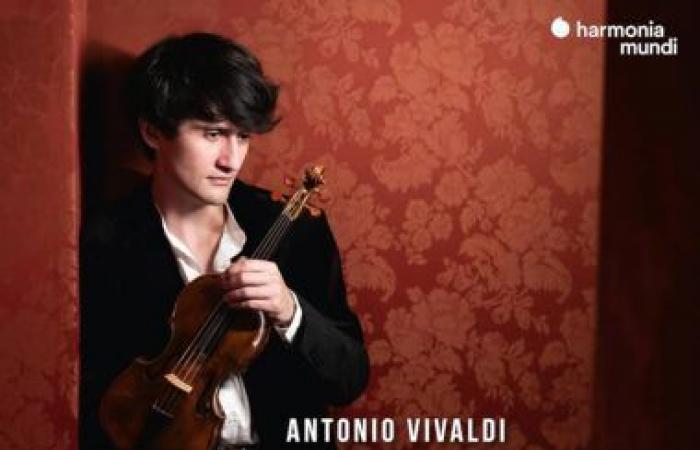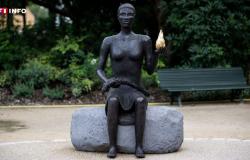More details
Antonio Vivaldi (1678-1741): Works for violin and orchestra RV 168, 813, 768, 356, 256, 370, 315, 349, 267a, 478, 171, 212, 278, 37a, 539, 714, 709, 250, 237, 252, 569, 667, 583. Giovanni Legrenzi (1626-1690): Aria “Occhi miei si dormie”; Aria “Lumi potete piangere”. Johann Paul von Westhoff (1656-1705): Imitazione delle campana. Jean-Joseph Mouret (1682-1738): Fanfare. The Consort, Théotime Langlois de Sawarte: violin and direction. 2 CD Harmonia Mundi. Recorded in May and July 2023. Presentation instructions in French and English. Total duration: 120:28
Harmonia Mundi
This album opens us an incredible universe of Vivaldi pieces buried in his immense catalog of more than 500 concertos. Théotime Langlois de Swarte and his ensemble Le Consort take us into a dazzling whirlwind of color and virtuosity.

Two well-filled CDs offer us more than two hours of Vivaldian music, drawn from his large production of pieces for the violin. It is true that we usually hear the same concertos, even if certain record collections have also explored the subject, including that of the Naïve label. Young and very talented violinist, Théotime Langlois de Swarte places himself as a specialist in early music and the jubilant world of Vivaldian seems ideal to him. His lively enthusiasm allows us to hear Vivaldi’s music, not completely in a new light, but through an assertive and radiant personality.
The program begins in a special atmosphere with an Aria by Giovanni Legrenzi taken from his Opera The division of the world. A gentle polyphony brings a serene climate where the strings sing with emotion. We remember Bach himself being touched by this author to the point of writing a fugue on one of his themes (BWV 574). Then come several complete concertos for violin, alternated with a few isolated movements under various names (Ciaconna, Fantasia, Sinfonia, Fanfara, Tempesta…). The listener is caught in a ferment where the orchestra is bouncing, with verve, freshness and articulations of speech. This musical surge clearly shows the extent to which Vivaldi continually reinvents himself, certainly in a style that is his own and which brings the violin closer than any other composer in the form of the Venetian concerto in several movements.
What makes this program successful, beyond the works themselves, is the committed and inspired interpretation of the musicians with multiple instruments (strings, winds, percussion). Playing Vivaldi today reveals a particular science drawn from the study of ancient texts, original scores and carried by the use of ancient instruments or copies of ancient ones. In particular Théotime Langlois de Swarte plays a wonderful violin built by Jacob Steiner in 1665 and a bow by Pierre Tourte. What a long way we have come since the beginning of the 70s, where little by little an innovative way of approaching Vivaldi was emerging. In 1977 Nikolaus Harnoncourt and his Concentus musicus Wien offered as true pioneers a revolutionary version of the Qother seasons which almost caused a scandal at the time and which nevertheless projected itself completely into the future, with the visionary side that this exceptional leader then had.
This album even offers several new tracks allowing for some great discoveries of the greatest interest. Everything here breathes the air of Venice without forgetting the late Viennese period of the Red-haired Priest, marked by a piece “in imitation of bells” by Johann Paul von Westhoff. The concert ends with an intoxicating chaconne in B flat, still taken from a concerto this time “a due cori con violine discordato”.
(Visited 1 times, 1 visits today)
More details
Antonio Vivaldi (1678-1741): Works for violin and orchestra RV 168, 813, 768, 356, 256, 370, 315, 349, 267a, 478, 171, 212, 278, 37a, 539, 714, 709, 250, 237, 252, 569, 667, 583. Giovanni Legrenzi (1626-1690): Aria “Occhi miei si dormie”; Aria “Lumi potete piangere”. Johann Paul von Westhoff (1656-1705): Imitazione delle campana. Jean-Joseph Mouret (1682-1738): Fanfare. The Consort, Théotime Langlois de Sawarte: violin and direction. 2 CD Harmonia Mundi. Recorded in May and July 2023. Presentation instructions in French and English. Total duration: 120:28
Harmonia Mundi
Keywords of this article







